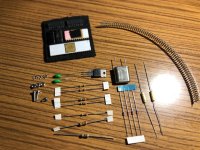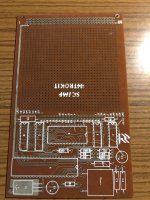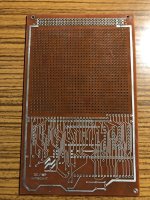As a follow up to my IBM 5100 discussion at VCF-SW earlier this year:
In honor and celebration of the 50th anniversary of the IBM SCAMP prototype development, we've been able to coordinate a "once in a generation" review of the Smithsonian Institutes archive collection of documentational artifacts related to the SCAMP development. These documents were donated by IBM several decades ago, including the personal notebooks of Joe George (one of the prime hardware engineers), and numerous other persons involved.
These documents have given tremendous insight, and verification, to that process of development. I am still working on decomposing all of the material (into "high def" formats that now the broader community can view digitally).
SCAMP notes: (photos and PDFs)
In July 2023, circumstances came about that I came in contact with one of the department heads at the American History Smithsonian Institution in Washington, DC. After some discussions and planning, it was agreed I could examine their SCAMP archive. In particular, the Joseph D. George...

voidstar.blog
Special Computer APL Machine Portable Archive Material - voidstar78/SCAMP

github.com
IBM 5100 notes:
Archive of documents related to the IBM 5100 (opcodes ISA) - voidstar78/IBM_5100_DOCS

github.com
As an initial summary of some insights and stories:
- Early PALM-2 did not yet have SHIFT REGISTER support. This was implemented in hardware on the SCAMP and subsequently added to PALM, making it far more practical to implement the System/3 BASIC emulation. Another (earlier) description of the PALM instruction appears, as a "Chapter 3.0", but this one more clearly dated as being from March 1972 -- but, as noted, it does not have the SHIFT (or ROTATE) instructions that appear in the more final PALM instruction set a couple years later.
- Confirmation that the notion of supporting multiple programming languages motivated some of the architectural designs of SCAMP (this comes directly from Paul Friedl's early January 1973 discussions about SCAMP).
- The GEM vs PALM debate: it seems Joe George himself was involved in an alternative "engine" called GEM that was planned to be an eventual replacement to PALM. But as far as I can tell, GEM never ended up being used. (however, in some context, it appears GEM is actually a broader emulation component - not an instruction set; but later discussions do describe "PALM vs GEM" and tout GEM as being superior)
- The Norelco audio cassette storage concept was actually borrowed from the System/7. But even by 1973 it was acknowledged this was an aging solution (and Norelco was soon to end of life the product altogether). IBM considered various alternatives of disk drives actually ranging from 3.5", 4.5", 5", and 6" (one in particular called the Flexidisk). Ultimately they did go with the 3M DC300 solution, but it is evident that "higher ups" strongly desired a portable disk solution as-soon-as-possible (the proposed solutions were still estimated at "18-24" months before being viable, so integration of "something smaller than the 8in disks" before 1975 just wasn't practical). To his credit, Joe George has many pages of calculations of the RPM and necessary power requirements to consider in trying to integrate any of the disk options.
- Confirmation on the name "Snoopy" in reference to early RWS/RAM module.
After the September 1973 demo in Atlanta, SCAMP had a "funding secured" moment and lots of ideas began to flow. Some ideas:
- immediate interest in expanding the system to 9" or even possibly 12" display, and consideration of a color CRT
- Reference to a "hand scanner" option (not sure what that was about)
- Reference to use of "bubble memory" (brought up in 1973)
- the 3.5" floppy disks as mentioned above
- integration of audio (not just a beep speaker, but the idea of the computer talking instructions to you {use case of Field Engineers})
- References to a 128KB RAM option: Joe George describes some technical ideas on how to do a switch to get to this additional memory. I take it to mean a literal front panel switch, not the concept of bank-switching, though I could be wrong.
- References to "shadow memory" and "reverse APL notation." (terms used by Paul Friedl) I don't think there is any real mystery to shadow memory, it was just something similar to "workspace memory" or "virtual memory." But I've never heard of "reverse APL notation."
- References to the graphics plotting system being developed by Dennis Roberson (i.e. an actual graphics card for the IBM 5100, as opposed to just a "character generator").
- Kitty Price goes on maternity leave starting December 1973. She is a vital APL expert, so this causes some concern. Specifically, there is a plan to expand the APL precision from 7 to 11 digits, but she is the only who knows how to do it. There is budgeted about a 4-week training to "knowledge transfer" to some other college hire. Ultimately, it appears the best compromise Kitty does is to hand write a several page letter on the approach (dated August 1973, four months before her scheduled maternity leave). [at the moment, I don't recall what the final APL precision ended up being in the IBM 5100 or 5110 - so I'm not sure if her approach was implemented, but her handwritten description is very admirable]
- There is a reference to needing to order "500 keyboards" in 1974, and Joe George shows some production estimates from 1974 to 1979. The total for this is 34,000 units -- which we think is close to what IBM actually did end up making. But curiously, there is an estimate of about 450 units in 1974. So, it could be IBM did actually built some before 1975 -- either (1) for special eager customers, early adopters, or just key developers, or (2) maybe just a trial run to practice ramping up production.
NOTE: Just this year, the Commander X16 project in Texas is going through a similar experience - of having to pre-order keyboards, and doing an initial "test" production run of ~100 units (to help iron out any kinks as they then start to ramp up production, but also to get the system into the hands of early developers).
- There is a single page letter dated January 22, 1973 by Joe George that contains two interesting comments: (1) reference to a "basic 62 GV" file request and an Audio Exchange Program, and (2) a mention of the name "Howard Kazan". This second bit is interesting, because the name is extremely close to the author of the famous IBM 5100 book, "Harry Katzan." The Smithsonian associates reminded me that back in those days, secretaries often typed letters from handwritten notes - so it's possible Joe maybe wrote the name down wrong, or it was mis-typed by the secretary who prepared the typed letter. If it is the same name, then it is curious that Mr. Katzan got such an early involvement on the project (in 1973). The other extreme possibility is use of a pseudo name, as some authors do.
- There is a reference to "Calico Keyboards." I'm not sure if that's a type-of-keyboard or a brand (i.e. a company that makes keyboard). In any case, there is a "rant letter" dated October 10, 1973 (that being about one month after the great SCAMP demo). The rant is in regard to the request to have two colors of keys. "Standard Calico" keys are (per the rant) a mix of white/black and blue/white - whereas for the IBM SCAMP, the request is apparently to do something different (SCAMP has white/black and white/gray, the 5100 ended up with black/white and white/gray). The rant is about "serious keybutton material shortage" and being able to meet the desired schedule and cost, and in their opinion "sees no reason why you cannot use standard colors." Ah, fun times!! I never saw any blue keys on any 5100, so I think IBM got their way.
Some things not found:
- There is a mention of HP (specifically the HP9830) but absolutely no mention of Wang as a competitor. In 1974, there was "aggressive" discussions about implementing a word processor software, and explicit mention of several other competitors' systems. Just I'm curious on the lack of any mention of Wang as a competitor (nor any mention of Wang in regard to the 5.25" disk format they, per my understand, Wang did eventually get working first- but that was probably post 1975, where Joe's involvement was less so).
- At no point is the actual meaning of SCAMP or PALM or GEM ever mentioned. But likewise, there is never any spelling-out of the meaning of APL or BASIC. I take this as a "corporate culture" of there never being any urgency to declare acronym meanings in correspondence. Unfortunately for us, it means we don't really get an "official" or "originators opinion" about it.
- In all this material, there was never a mention of the model number "5100". There is mention of SCAMP II and SCAMP III and corresponding follow up plans. That said, my impression is that after the success of SCAMP, by 1974 Joe George was starting to engage more in other projects in IBM - he remained as an available technical advisor, but with most of the technical hurdles solved, the day-to-day development likely moved on to other persons.








